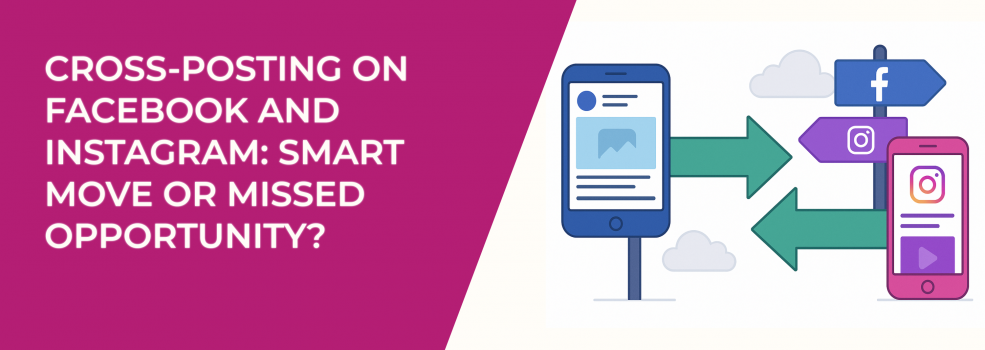You’re managing content across both Facebook and Instagram — captions here, reels there, hashtags everywhere. It’s a lot to keep up with. But what if you could post once and share the same content to both platforms automatically? Sounds like a time-saver, right?
That’s exactly what cross-posting on Facebook and Instagram offers. It allows you to post on Instagram and have that same content appear on your connected Facebook Page. Whether you choose to do it automatically or manually, it can be a real time-saver.
But before you flip on that cross-posting toggle, let’s take a closer look. Is this smart content-sharing strategy actually helping your brand or holding it back?
Why Cross-Posting on Facebook and Instagram Is So Tempting
For small business owners and solo marketers, managing two platforms can feel like double the work. Keeping content fresh on both Facebook and Instagram every single day? Not easy.
Crossposting between Instagram and Facebook is appealing because it simplifies your workflow.
Here’s how it works:
-
You post a new reel or photo on your Instagram business or creator account.
-
If your account is linked to a Facebook Page, the content is automatically shared to Facebook — no need to re-upload or reformat.
It’s especially useful if:
-
You’re working with a small team (or just by yourself).
-
You want to maintain a consistent presence across platforms.
-
You’re looking to grow brand visibility without doubling your effort.
To get started, you’ll need:
-
A professional Instagram account (business or creator).
-
A Facebook Page.
-
Admin access to the Page.
Once your Instagram and Facebook accounts are connected, you can enable automatic crossposting for posts, stories, reels — or all of them. You’re in control of what gets shared.
So yes, it’s efficient. But is it always the best move?
Crossposting Isn't One-Size-Fits-All
Even though Facebook and Instagram are both part of Meta, they’re not identical. User behavior, tone, and content expectations can be very different across the two.
For example:
A behind-the-scenes reel with trending music might perform well on Instagram. That platform thrives on short, eye-catching video and mobile-first design. But that same video might feel out of place on your Facebook Page — especially if your audience there is older or prefers more traditional updates.
When you crosspost Instagram content to Facebook, the formatting, tone, and even your call-to-action might not land the same way. That’s where it can become a risk if you’re not adjusting your content to fit each platform’s audience.
Ask yourself:
-
Does this post speak the same way to both Instagram and Facebook audiences?
-
Are the hashtags and CTAs still relevant?
-
Does the video thumbnail or caption need tweaking for Facebook?
If your answer is “not really,” a little customization can go a long way before you crosspost your Instagram content to Facebook.
Want to understand the unique strengths of each platform? This article on Instagram Ads vs Facebook Ads explains when and how to use each one effectively.
Does Instagram Crossposting Hurt Engagement on Facebook?
This is a common concern among advertisers and social media managers. Meta doesn’t officially penalize crossposted content, but many marketers have noticed that native Facebook posts often perform better.
That's because Facebook’s algorithm tends to reward content that’s created directly for its platform. When you share Instagram posts to Facebook, your video or image might not be fully optimized — from thumbnail selection to caption structure or engagement tools.
Understanding user demographics and behaviors on each platform is essential for effective cross-posting.
And don’t forget technical mismatches:
-
Instagram stickers and music often don’t carry over correctly to Facebook.
-
Formatting can look off — captions may get truncated, line breaks disappear, or interactive elements break.
These issues might not seem like a big deal, but they can reduce your engagement subtly over time and make your brand appear less polished.
When Cross-Posting from Instagram to Facebook Makes Sense
That said, posting the same content on both platforms definitely has its place in a smart social media strategy.
Use it when:
-
You’re launching a new product and want to quickly increase visibility across both platforms.
-
You’re promoting a time-sensitive offer or event and don’t have time to customize.
-
You’re building a presence on one platform and need content to keep the feed active.
In these cases, cross-posting helps you stay visible without spending extra time. The key is to use it intentionally — not automatically for every single post.
Best Practices for Cross-Posting Instagram Content to Facebook
Want to get more out of cross-posting between Instagram and Facebook? Follow these simple but effective strategies:
1. Tweak your captions
The same photo or reel can work on both platforms, but your caption shouldn’t be copy-pasted. Instagram favors short, casual, emoji-filled text. Facebook often needs more context.
Tip: cut down hashtags for Facebook, add a clearer call to action, and adjust the tone to match your audience.
2. Fix the formatting
Instagram formatting doesn’t always carry over cleanly. Line breaks disappear, emoji placement shifts, and hashtag blocks can look cluttered on Facebook.
Before publishing, double-check your text to make sure it’s readable and polished on both platforms.
3. Choose the right content types
Some formats crosspost better than others. Reels work well on both platforms, but stories don’t always translate — interactive stickers and features may not show on Facebook.
Test and adjust based on what drives results for your audience.
If you're looking to get more reach from short-form video, here’s a helpful guide on how to use Instagram Reels in your marketing strategy — especially if you want to crosspost video content without losing engagement.
4. Track performance
Use Meta Business Suite to compare engagement on cross-posted vs. native content. Look at reach, clicks, and reactions to see what’s working — and where to improve.
Let performance data guide how often (and what) you crosspost.
5. Post natively when it matters
For campaigns, ads, or anything with a clear goal, post separately to each platform. Tailored content performs better when the stakes are higher.
Final Thoughts
Crossposting between Instagram and Facebook isn’t a bad idea — but it’s not always the best idea, either. It’s a tool, and like any tool, it’s only as effective as the person using it.
Used without thought, it can make your content feel repetitive or irrelevant. But when used with purpose, it can save time, boost consistency, and help you do more with less.

